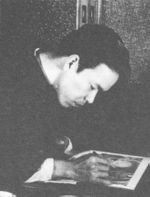Toshiyuki Suma
Suma (須磨) family name, Toshiyuki (利之) first name, (1920- 1992)
Contents
Activities
Painter/illustrator, rope artist, writer and editor. Suma did editorial work in early SM magazines like "Kitan Club," "Uramado," "SM Collector," "Abu-Hunter" and "SM Kitan." He played an important role in the formation of post-war SM culture and left behind first-class work as a writer and rope artist.
Alternate Name(s)
須磨利之(Japanese), Reiko Kita, Kou Minomura, Eijiro Takenaka[1], etc..
Biography
Since it is believed that Suma's autobiographies include a few invented anecdotes, the biographical data below could contain inaccuracies. Therefore, the following biography may be corrected in the future.
1920, Suma was born in Kyoto to a family who ran a printing business out of their home[2].
ca1932, As a child, he encountered Seiu Itou's torment art in the book Documentation on Abnormal Customs, which he found in his grandfather's book collection[3].
1930s, Suma left the Kyoto School of Fine Arts at midterm and became the live-in apprentice to the Japanese painter Baisen Kobayashi[4].
May 1939, Volunteered for the Navy in Maizuru, Kyoto[5].
March 18, 1944, Suma's ship, the "Hokuriku Maru," sank in the Bashi Channel[6].
ca1945, Suma was discharged from navy and wandered across Japan and was employed at various jobs before becoming an editorial reporter for the evening newspaper "Central Kyoto News."[7].
Summer, 1947, Kiyoshi Sugiyama, who worked in "Central Kyoto News," took Suma to the editorial office of Kitan Club (Akebono Shobo), which gave Suma a chance to begin drawing illustrations for Kitan Club[8]. There were other irregularly published pulp magazines besides Kitan Club, and Suma drew illustrations for "Jouen Shin-syu" and others as well.[9][10].
Selected Works
Notes
- ↑ Painted in the style of Eitaro Takenaka. Years later, Suma was visited by Eitaro Takenaka's son, the critic Tsutomu Takenaka.
- ↑ After his father's death, Suma's uncle, Kanbee Suma, became the head of the family.
- ↑ Masami Akita, Chimuo Nureki, Fuji Akio, History of Japanese Kinbaku Photography 1 (Jiyukokuminsha, 1996)
- ↑ In a place called the Saganosho Babachou Tenryuji in the Ukyo ward of Kyoto.
- ↑ Koushi Shimokawa, The Paradise Trade - A History of the Essential Nature of Post War Accounts (Chikuma Shobo, 1998)
- ↑ Suma's account is nothing but a fictional story, but a merchant transport ship called the "Hokuriku Maru" actually existed. The Hokuriku Maru was commissioned by the navy in 1941 and served in the sea battles of Guadalcanal, Midway and the attack on Menado in 1942. In 1944, the Hokuriku Maru left Singapore loaded with 6700 tons bauxite, 600 tons of oil, 256 soldiers and headed toward Moji. On March 18th at 1:14a.m., while in the China Sea roughly 300km southeast of Hong Kong, an ammunition explosion in the second hold caused the first hold to explode, which ignited and detonated the oil tanks in the third hold, reaching the engine room. Everything was lost in five minutes. 8 soldiers, 25 guards and 55 sailors perished.
- ↑ Akita, History
- ↑ There's a conflict in stories between whether Kitan Club was founded in 1946 or in October of 1947. A visit will be made this summer to try to confirm the latter.
- ↑ Shizuo Yagi, who used the alias Mineko Tsuzuki (都築峰子), took over as editor of "Glamorous New Collection."
- ↑ Akita, History
References
- Nureki, Chimuo. The Artists of Kitan Club. Tokyo: Kawade Shobo Shinsha, 2004. Print.
- Akio, Fuji, Masami Akita, and Chimuo Nureki. History of Japanese Kinbaku Photography 1. Tokyo: Jiyukokuminsha, 1996. Print.
- Shimokawa, Koushi The Paradise Trade - A History of the Essential Nature of Post War Accounts. Tokyo: Chikuma Shobo, 1998. Print.
